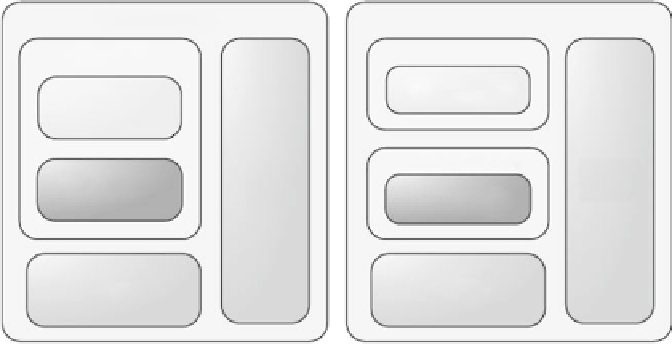Image Processing Reference
In-Depth Information
circuit boards, either actual hardware or of layout with design modifications, has a direct saving in
production cost, testing, and competence buildup. Reuse of mechanical solutions such as the pack-
aging of the device often has large direct cost savings due to the elimination of design costs and
cost of tooling. However, you need to balance the cost savings associated with utilizing a common
housing, with the design restrictions, this will put on other parts of the design (form factor, antenna
placement/design, etc.).
Reuse of software components is advantageous under the condition that the sum of costs related to
purchasing the code (internal or external), competence buildup, modification of components, inte-
gration of components, and testing is less than the cost of designing a component from scratch.
Experience has shown that this is not easy unless other elements of the development organization are
in place such as clear organizational roles, requirement management, product platform architecture,
and design, etc.
27.8.1.2 Single vs. Multiple Chips
One of the major design choices that must be made is whether to integrate functionality in one hard-
ware chip or to have it distributed into different chips. In certain cases, there is no choice, the desired
functionality is only supplied as a separate chip, i.e., as a COTS component, while in other cases
thecomponentcanbedesignedin-houseandsuitablylocated.Typicalfunctionalityandsubsystems
available in a WSN device are CPU, radio communication, sensor, signal processing (filters, DSPs,
etc.), RTC, external memory (RAM, ROM, Flash, etc.), HMI (LEDs, buttons, etc.), and an AD con-
verter.Manyofthesesubsystemscouldbeintegratedintoonechip,e.g.,theCPUcouldcontainalmost
everything.
A typically design choice for a WSN sensor device is whether to separate the radio communi-
cation stack and the application into different chips (see Figure .). To conclude on a suitable
solution, a trade-off between low-level control, form factor, cost, overhead, and performance has
to be made.
Figure . above shows a very clean separation between the application and the communication
stack. In reality, this separation is often far from clear. A typical example is what a stack supplier
considers being part of the communication stack and what is considered to be the “application” (and
thus excludes from the supplied stack offering).
Single chip design
Multiple chip design
CPU/memory
Radio chip
Communications
stack
Communications
stack
CPU/memory
Power
source
Power
source
Application
Application
Sensor
Sensor
FIGURE .
Exampleofsinglevs.multi-chipsolution.








